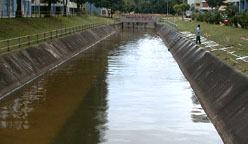
Storm Drains on the Bukit Temasek Road
 Bukit Temasek Road -- straight, treelined and broad; capable of carrying eight lanes of traffic: four going up and four going down. An eight o'clock sun, serious about its business of shining bright and hot to remind Singaporeans below that the world did not owe them a living. Buses, cars and trucks speeding past each other to reach their destination on time. Independent Singapore always in a hurry. From the bus Marie looked beyond the cars at the monsoon drain on her right, straight and wide, running down the middle of the road with four lanes of traffic and a row of Rain Trees on each side. A huge drain, fifteen metres wide and fifteen metres deep, its concrete sides rising at a 70-degree angle and shining glaringly white in the morning sun. By international standards this was the cleanest monsoon drain in South-East Asia; almost devoid of man-made rubbish like soggy cardboard cartons, beer cans, broken bottles, foul-smelling carcasses of dogs, ducks and chickens. It was even devoid of Nature-made rubbish like rotting tree trunks, pieces of driftwood and fallen leaves. Ah, but this monsoon drain was not built to become a communal dustbin as most monsoon drains in South-East Asia inevitably become.
Bukit Temasek Road -- straight, treelined and broad; capable of carrying eight lanes of traffic: four going up and four going down. An eight o'clock sun, serious about its business of shining bright and hot to remind Singaporeans below that the world did not owe them a living. Buses, cars and trucks speeding past each other to reach their destination on time. Independent Singapore always in a hurry. From the bus Marie looked beyond the cars at the monsoon drain on her right, straight and wide, running down the middle of the road with four lanes of traffic and a row of Rain Trees on each side. A huge drain, fifteen metres wide and fifteen metres deep, its concrete sides rising at a 70-degree angle and shining glaringly white in the morning sun. By international standards this was the cleanest monsoon drain in South-East Asia; almost devoid of man-made rubbish like soggy cardboard cartons, beer cans, broken bottles, foul-smelling carcasses of dogs, ducks and chickens. It was even devoid of Nature-made rubbish like rotting tree trunks, pieces of driftwood and fallen leaves. Ah, but this monsoon drain was not built to become a communal dustbin as most monsoon drains in South-East Asia inevitably become.
This was built to remain a monsoon drain. Its function was to drain off excess water. This was a product of the kind of rational planning praised by Paul, aimed at
[49]
References
Su-chen Christine Lim. Rice Bowl [1984], Singapore: Times Editions, 1991.




 Bukit Temasek Road -- straight, treelined and broad; capable of carrying eight lanes of traffic: four going up and four going down. An eight o'clock sun, serious about its business of shining bright and hot to remind Singaporeans below that the world did not owe them a living. Buses, cars and trucks speeding past each other to reach their destination on time. Independent Singapore always in a hurry. From the bus Marie looked beyond the cars at the monsoon drain on her right, straight and wide, running down the middle of the road with four lanes of traffic and a row of Rain Trees on each side. A huge drain, fifteen metres wide and fifteen metres deep, its concrete sides rising at a 70-degree angle and shining glaringly white in the morning sun. By international standards this was the cleanest monsoon drain in South-East Asia; almost devoid of man-made rubbish like soggy cardboard cartons, beer cans, broken bottles, foul-smelling carcasses of dogs, ducks and chickens. It was even devoid of Nature-made rubbish like rotting tree trunks, pieces of driftwood and fallen leaves. Ah, but this monsoon drain was not built to become a communal dustbin as most monsoon drains in South-East Asia inevitably become.
Bukit Temasek Road -- straight, treelined and broad; capable of carrying eight lanes of traffic: four going up and four going down. An eight o'clock sun, serious about its business of shining bright and hot to remind Singaporeans below that the world did not owe them a living. Buses, cars and trucks speeding past each other to reach their destination on time. Independent Singapore always in a hurry. From the bus Marie looked beyond the cars at the monsoon drain on her right, straight and wide, running down the middle of the road with four lanes of traffic and a row of Rain Trees on each side. A huge drain, fifteen metres wide and fifteen metres deep, its concrete sides rising at a 70-degree angle and shining glaringly white in the morning sun. By international standards this was the cleanest monsoon drain in South-East Asia; almost devoid of man-made rubbish like soggy cardboard cartons, beer cans, broken bottles, foul-smelling carcasses of dogs, ducks and chickens. It was even devoid of Nature-made rubbish like rotting tree trunks, pieces of driftwood and fallen leaves. Ah, but this monsoon drain was not built to become a communal dustbin as most monsoon drains in South-East Asia inevitably become.